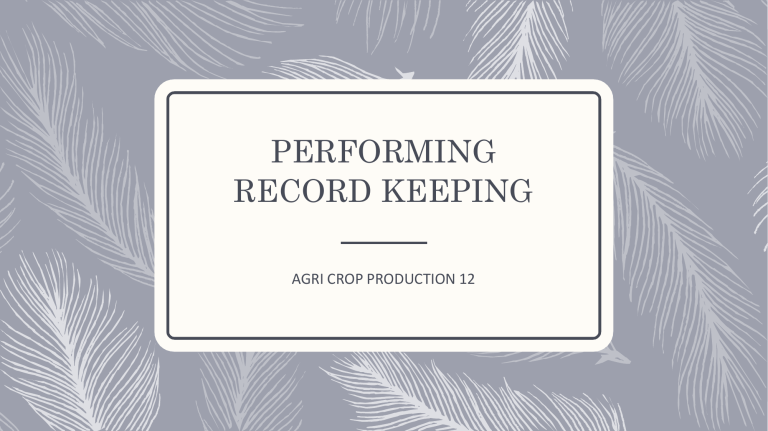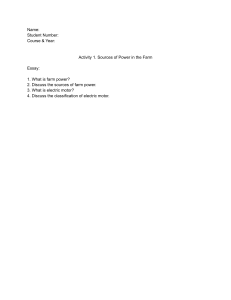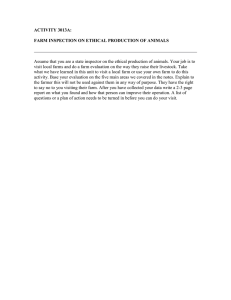
PERFORMING RECORD KEEPING AGRI CROP PRODUCTION 12 LEARNING OUTCOME 1 CARRY OUT INVENTORY ACTIVITIES LO 1 1.1. Determine Inventory inputs according to enterprise requirements 1.2. Determine defective tools and equipment according to operation manuals 1.3. Inspect facilities according to standard codes and laws Pre Activity Directions. Encircle the following terms in the password puzzle. Lesson 1.1 Determine Inventory Inputs According to Enterprise Requirements To facilitate the management of the farm, the farmer should maintain records to show his/her expenses in the operation of the farm. The record should show his/her expenses for materials, labor and other expenses, and more importantly his/her sales. Without the records, he/she may not be able to know if he/she is gaining or losing in the operation of the farm. These records should be kept up to date, complete and accurate. In this lesson, we will focus on determining farm inputs according to enterprise requirements. Activity Read the situation below and answer the following questions in your activity notebook. Situation The farm of Mang Juan was hit by Typhoon Pablo. The rice field, garden and the house was flooded. He suffered great loss due to typhoon. After the typhoon, Mang Juan decided to avail a loan from Land Bank of the Philippines. He returned to his house and looked for the documents needed for the loan application but he was not able to find those documents Give you Answers 1. What happened to the farm of Mang Juan? Answer_______________________________________________________. 2. If you were Mang Juan, where are you going to keep your documents for safekeeping? And why? Answer_______________________________________________________. 3. And what are examples of documents to be kept? Answer ______________________________________________________. Group Activity Directions: Using the Semantic Web, describe the word record keeping by choosing appropriate word or group of words inside the box Importance of Keeping Farm Records 1. Farm records provide facts, it should include the cost of production of vegetable crops, the yields, expenses and income the grower’s financial position and net worth. 2. In maintaining the records, one may be able to determine the efficiency and deficiency factors of the operation. 3. Records aid in controlling the current farm operation. The records will show whether his/her investments obtained the return as per plan on budget under which he/she is operating based on the farm’s performance. INVENTORY OF FARM INPUTS The purpose of inventory is to provide information as to the utilization and availability of farm inputs such as fertilizers, seeds, pesticides and insecticides. It will help the farmers to decide whether or not they will buy additional farm inputs for the farm operation for the next planting season. The result of inventory should be recorded, kept up to date and accurate. INVENTORY METHODS A. Manual – involves using inventory sheets and pencil to record the actual count manually. B. Electronic – involves using technology. In small farm, it is advisable to use the manual method. STEPS IN THE PROCESS OF FARM INVENTORY 1. Plan During planning, the date of the inventory and the persons responsible for the tasks should be considered. 2. Prepare the stockroom/storeroom 3. Segregate farm inputs from farm tools, implements and equipment. 4. Count 5. Consolidate the result of the count 6. Record Here is an example of Farm Inventory Form Table 1. Inventory Form Data needed in Inventory Form Date – write the date of inventory Item – name of farm inputs Unit of Measure - standard of measurement (Examples: kilogram, bot., bag, mg., etc Quantity – number of items Unit Value – the amount paid for the item On Hand per Count – shows the farm inputs that are available in the stockroom. Based on the given example, answer the following questions: 1. How many bags of fertilizers are available in the stockroom? Ans. _________________ 2. How many bags of seeds are available for the next planting season? Ans. _________________ ARRANGE THE STEPS CHRONOLOGICALLY Directions: Arrange the steps in the process of Farm Inventory. Write the number on the space provided before each number. ____ Plan ____ Segregate farm inputs from farm tools ____ Prepare the stockroom/storeroom, implements and equipment. ____ Count ____ Record ____ Consolidate the result of the count Activity. Given the result of actual count, prepare an Inventory Record using Table 1. Inventory Form. One point for every correct answer. A. Multiple Choice Directions: Read the questions carefully and select the best answer. Write your answer in your activity notebook. 1. It shows the date of inventory. What is it? a. Date b. Item c. Unit of measure d. On hand per count c. Unit of measure d. On hand per count 2. What shows the name of farm inputs? a. Date b. Item 3. It shows the farm inputs that are available in the stockroom. What is it? a. Date b. Item c. Unit of measure d. On hand per count 4. What method is using inventory sheets and pencil to record the actual count manually? a. Electronic b. Specific c. Manual d. Weighted 5. What method is using technology to record the actual count? a. Electronic b. Specific c. Manual d. Weight LESSON 1.2 Determine Defective Tools and Equipment According to Operation Manuals Complete the statement. Directions: Complete the statement by selecting the appropriate words below. 1. Never __________a defective tool. 2. Double check all __________ prior to use. 3. Ensure __________ tools are repaired. 4. Farm __________ occur due to the operation of defective tools and equipment. 5. __________ are tools and equipment that are not able to perform its regular function. Why maintain inventory of tools and equipment? A farmer should maintain tools and equipment on a regular basis. In doing so, it will maximize the lifespan of the tools and equipment and reduce farm accidents due to the operation of defective tools and equipment in the workplace. To achieve that, inventory of farm tools and equipment is needed. Words to Remember… 1. A complete list of items such as property, goods in stock, or the contents of a building. 2. Having a defect or flaw, imperfect in form, structure, or function. Activity. Identification of Pictures Directions: Identify the pictures below. Write F if tools are functional and NF if tools are nonfunctional. FUNCTIONAL Vs NON FUNCTIONAL Functional Tools and Equipment – are those that are in good condition and can perform its regular function. Non Functional Tools and Equipment – known as defective tools and equipment are those tools that are not able to perform regular function because of impaired and damage parts. Remember: 1. Never use a defective farm tool and equipment. 2. Double check farm tools and equipment prior to use. 3. Ensure defective tools and equipment are repaired. 4. Farm accidents occur due to the operation of defective tools and equipment. 5. Non - functional are tools and equipment that are not able to perform its regular function. How to Conduct Inventory of Farm Tools and Equipment? Step 1. Make a checklist of farm tools and equipment. Step 2. Check/Inspect farm tools and equipment. Step 3. Label the farm tools and equipment that are defective. Step 4. Segregate the farm tools and equipment which are in good condition from the defective ones. Step 5. Count the farm tools and equipment (both functional and non-functional). Step 6. Record the actual count in the Record book. Make a separate record/list of defective tools. Step 7. Prepare an inventory report by using Inventory Form. Note: Keep the result of inventory. Table 2. Sample Checklist of Farm Tools Table 3. Sample Checklist of Farm Equipment Note: After accomplishing the checklist, proceed to Inventory Form by indicating the date of inventory, items, unit of measure, unit value and the actual count of the items. Table 4. Sample Inventory Form for Functional Farm Tools Table 5. Sample Inventory Form for Non Functional Farm Tools Table 6. Sample Inventory Form for Functional Farm Equipment Table 7. Sample Inventory Form for Non Functional Farm Equipment Date – write the date of inventory Item – name of farm inputs Unit of Measure - standard of measurement (Examples: kilogram, bot., bag, mg., etc Quantity – number of items Unit Value – the amount paid for the item On Hand per Count – shows the farm inputs that are available in the stockroom Performance Task Directions: In your home, make a checklist of farm tools and equipment. Indicate the condition of the farm tools and equipment by checking the appropriate box. Write your answer in your activity notebook. Follow Table 6.2 and 6.3 as your guide. Inventory Form for Functional Farm Tools Inventory Form for Non Functional Farm Tools LESSON 1.3 Inspect Facilities According to Standard Codes and Laws Why conduct a safety inspection? The most important responsibility of any farm owner or manager is to ensure the safety and health of his or her employees and family members. Most farm accidents are completely preventable. The farm owner or manager takes an approach to farm safety by conducting regularly scheduled and thorough inspections of the entire farmstead. TRUE or FALSE 1. As a farmer, you should use defective farm tool and equipment. 2. Double check farm tools and equipment prior to use. 3. Ensure defective tools and equipment are repaired. 4. Farm accidents occur due to the operation of tools and equipment in good condition. 5. Non – functional are tools and equipment that are not able to perform its regular function. What is the man doing in the farm? What is Agriculture Inspection? Agriculture inspection assesses all operations involved in food production agriculture, such as farming, logging, and fishing to ensure compliance with laws and quality standards. Agriculture inspections are closely related to food safety which also protects public health from any foodborne illnesses. What Should Be Inspected? 1. Farm House Farm house inspection is not just about making sure the cleanliness of it but will ensure the health and safety of the people working in the farm, save you money and time in the long run. 2. Farm equipment and machineries According to OHS (Occupational Health and Safety) Procedures, farm machineries must pass inspection before use. If any of the safety features are in despair, the farmer must not use the equipment to ensure safety. Ex. Tractor, thresher, harvester, corn miller, etc. 3. Chemicals Production of agricultural products involves the usage of various chemical substances such as pesticides, and herbicides. Many workers are exposed to these chemicals on a daily basis and without precautions and safety systems in place. Ex. Fertilizers, pesticides/insecticides and herbicides 4. Environmental factors Light, temperature, water, and soil—greatly influence plant growth and geographic distribution. These factors determine the suitability of a crop for a particular location, cropping pattern, management practices, and levels of inputs needed. Who should do the inspection? In small farms, the farm owner is the person in charge in the inspection of farm tools and farm equipment because he/she is familiar with the operation. But in big farms, the farm owner or manager hire safety professionals or inspectors with experience in detecting hazards and can provide assessment about hazards and risks in the farm/workplace. But both small and big farms are required to submit to government inspection to determine if the farm owners strictly follow government regulations mandated by law in its operation. How long will an inspection take? The length of time required to conduct an inspection will vary with the size and variation of farming facilities. A small farm safety inspection may only require 30 minutes to an hour. Large farms with several operations may require several days. When should the inspection take place? General farmstead inspections, as well as inspections of buildings may be conducted at any time. Inspection of farm machinery, grain handling, chemical, and fuel facilities should be conducted before the planting and harvesting seasons. It’s important to establish a regular safety inspection schedule. AGRICULTURE INSPECTION CHECKLIST This agriculture safety inspection checklist is designed to check the health and safety programs, workplace conditions, and hazards specific to agriculture of farms. Ensure safety on farms with this simple checklist. Activity 3: Inspecting Farm PPE and Chemical Analyze the following pictures and do inspection. Check the appropriate column according to standard and Laws Inspection Checklist of Personal Protective Equipment (PPE) CHECKLIST Does the farmer wear appropriate PPE during farm operation/activities? Does the farmer wear hand and arm protection if materials are likely to cut or scratch? Does the farmer wear respirator during application of fertilizer and spraying of insecticides? Does the farmer used earplugs to keep noise below the permitted level? Inspected by: Signature of Inspector: ___________________ Printed Name of Inspector: ___________________ Date of Inspection: ___________________ YES NO Inspection Checklists of Farm Chemicals stoarage are CHECKLIST Are the chemical stored in their respective cabinet or designated place Are the chemicals are properly labelled for easy identification Are there warning signs posted where workers enter the area where chemical are kept? Are there any instruction on the chemical for the proper us Are washing facilities available for workers who mix, load and apply pesticides Inspected by: Signature of Inspector: ___________________ Printed Name of Inspector: ___________________ Date of Inspection: ___________________ YES NO

